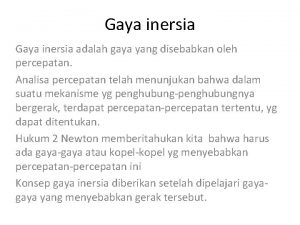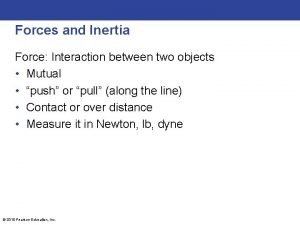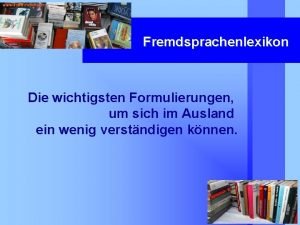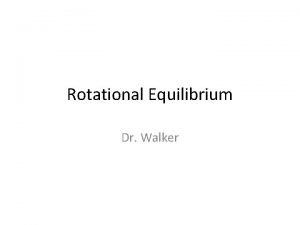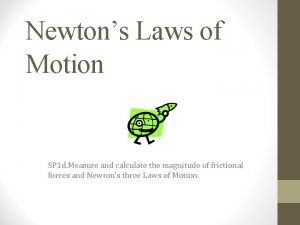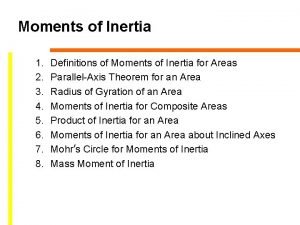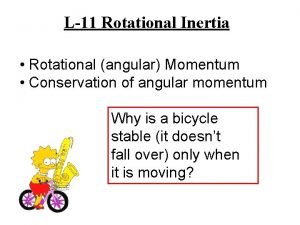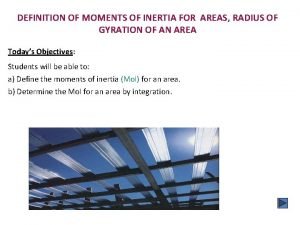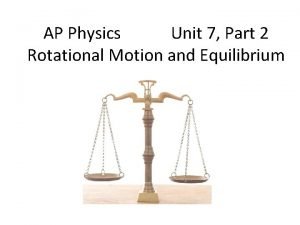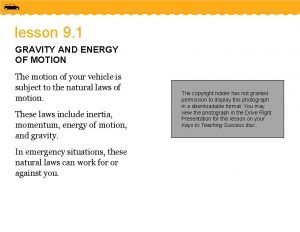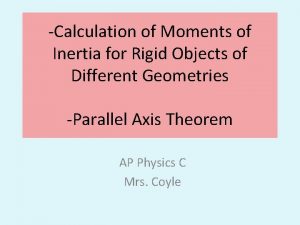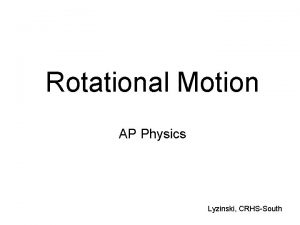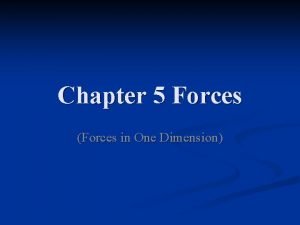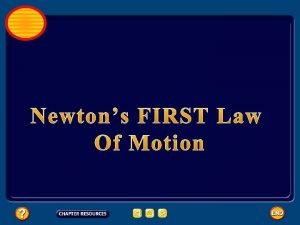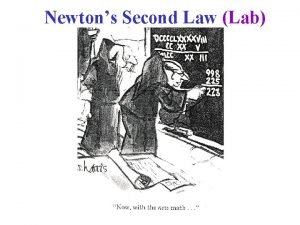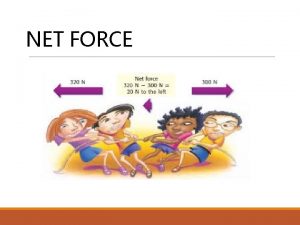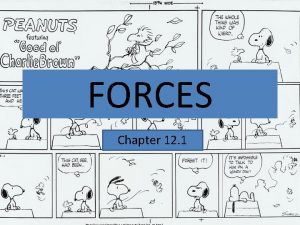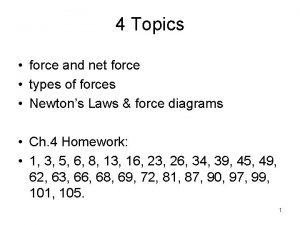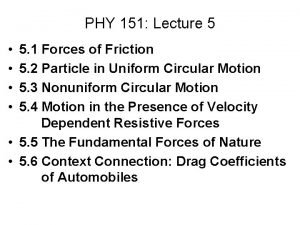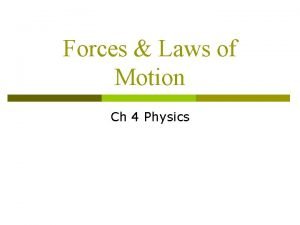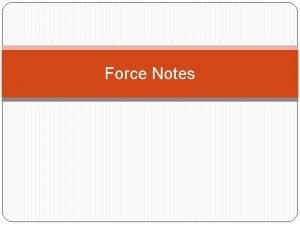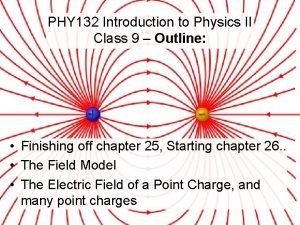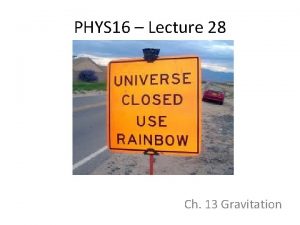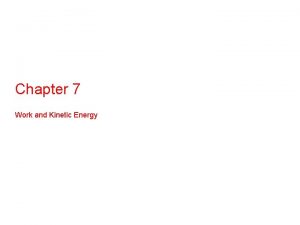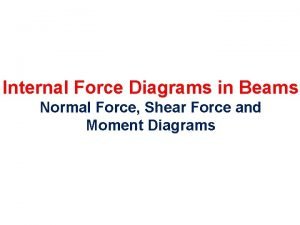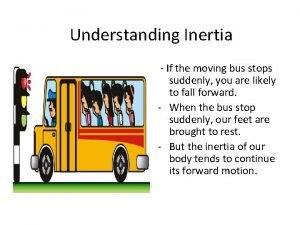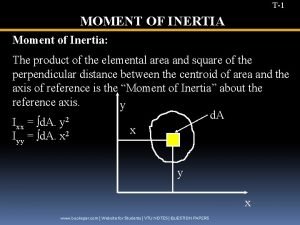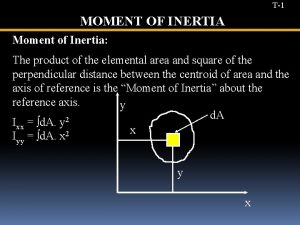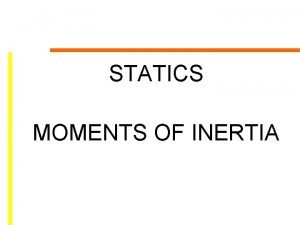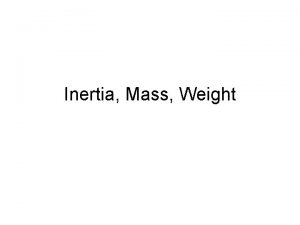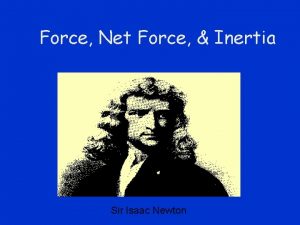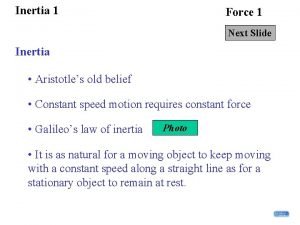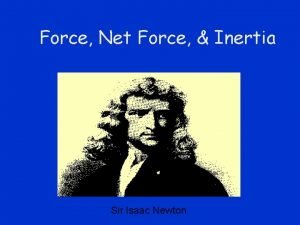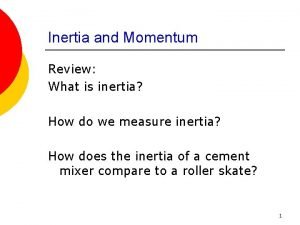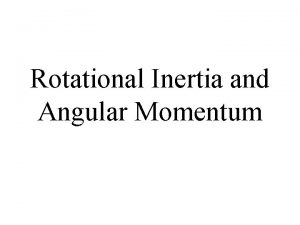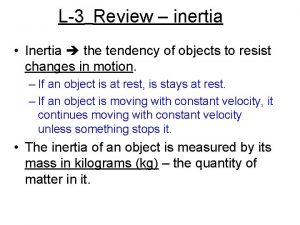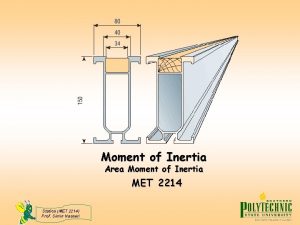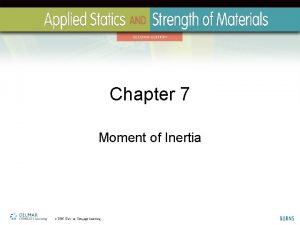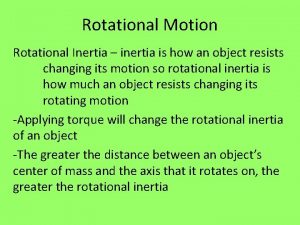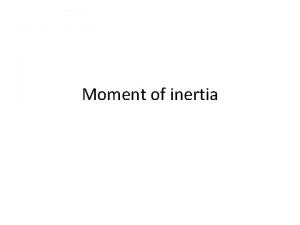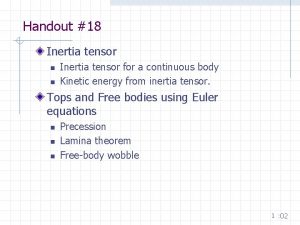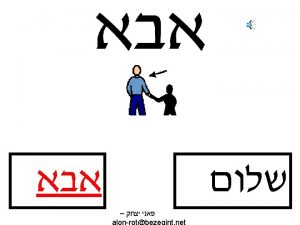4 Topics force and net force inertia and


















































- Slides: 50

4 Topics • • force and net force inertia and 1 st law acceleration and 2 nd law g notation force pairs and 3 rd law force diagrams equilibrium friction 1

Force Concept Force = push or pull Contact Forces – requires touch Ex: car on road, ball bounce Non-Contact – does not require touch Ex: magnetism, gravity 2

Net Force vector sum of all forces acting on an object 3

Newton’s First Law: An object maintains an unchanged constant velocity unless or until it is acted on by a nonzero Net Force. Example Motion Diagram when Fnet = 0 4

Example: Net Force = 0, Ball rolls along a smooth level surface constant velocity Force Diagram table force Fnet = 0 a=0 weight force 5

Example: Net Force = 0. Block on a surface inclined 30° from horizontal. Applied force F acts 40° below horizontal. Net Force = 0 velocity = constant 6

Newton’s Second Law: When a Net External Force acts on an object with mass m, the resulting acceleration of the object is parallel to the net external force and has magnitude of Example Motion Diagrams when Fnet ≠ 0 7

g’s • one “g” of acceleration = 9. 8 m/s/s • “two g’s” = 19. 6 m/s/s, etc. • Example: What is the net force on a 2100 kg SUV that is accelerating at 0. 75 g? 8

Inertia • The ‘resistance’ to a change in velocity • Ex: accelerating a ping pong ball • Ex: accelerating a train • Measurement: Mass • SI Unit: Kilogram (Kg) 9

Newton’s Third Law: Whenever one body exerts a force on a second body, the second body exerts an oppositely directed force of equal magnitude on the first body attraction repulsion 10

Newton’s Second and Third Laws in Operation: Ball hits a large block on a smooth level surface. Motion of Ball Force on Wall Acceleration of Ball Acceleration of Wall 11

Force Diagrams • Object is drawn as a “point” • Each force is drawn as a “pulling” vector • Each force is labeled • Relevant Angles are shown • x, y axes are written offset from diagram • Only forces which act ON the object are shown 12

Example of a Force Diagram for a Sled net force equals the mass times its acceleration. 13

Ex: Newton’s 2 nd Law Fnet acceleration upward (decreasing) velocity 14

Complete the table below for the sign of the net force. Sketch a motion diagram for each case. Velocity Acceleration Net Force + + – – – 15

Contact Forces • Normal Force – perpendicular to surface • Frictional Force – parallel to surface Static (no sliding) Kinetic (sliding) 16

Normal forces are? 1. Always vertically upward. 2. Always vertically downward. 3. Can point in any direction. 17

Static Friction • • Objects usually “stick” when at rest Must be “budged” to get them moving “Budging force” = fs, max. fs ranges from 0 to fs, max. 18

Kinetic Friction • After objects breaks free, friction decreases • fk = force that just keeps object moving at a steady speed 19

Coefficients of Friction dimensionless (no units) Ex. tire on dry road, static coeff. ~ 1. 0 dimensionless (no units) Ex. tire on dry road, kinetic coeff. ~ 0. 8 20

4 Summary • • Newton’s Laws of Motion force-diagrams and net force contact forces: normal, frictional, other equilibrium 21

nd 2 Newton’s Law Examples 22

Block on Frictionless Incline 23

Two Connected Blocks 24

A 3 kg object sits on a frictionless table. Two horizontal forces act, one is 2 N in the y-direction, the other 4 N in the xdirection. A top-view diagram will be shown. What is the magnitude of the net-force acting? 2 Fnet 2 4 25

What direction does the 3 kg mass accelerate in? Its acceleration is parallel to Fnet by Newton’s 2 nd Law. So we need to determine the direction of Fnet. We are in Quadrant I since x and y are both + 26

What is the magnitude of the acceleration? 27

Example: A 10 kg box is being pushed along a horizontal surface by a force of 15 N. A frictional force of 5 N acts against the motion. We will want to (a) Calculate the net-force acting and (b) calculate the acceleration of the box. The net-horizontal force determines its x-acceleration The y-acceleration is known to be zero because it remains in horizontal motion, thus The net-force is 10 N horizontal (0 vertical) The x-acceleration is: 28

29

Coefficients of Friction Ex: Block&Load = 580 grams If it takes 2. 4 N to get it moving and 2. 0 N to keep it moving 30

Example: 1. 3 kg box on level frictionless surface. F=86 N acts 60° below horizontal. 31

1. (cont) 32

Q 1. What are ax and FN if angle is 30? 33

34

2) 3 kg box at rest on frictionless 30° inclined plane. F acts 40° below horizontal. 35

36

Check of Previous Problem: 37

Q 2. 3 kg box at rest on frictionless 30° inclined plane. F acts horizontally. Calculate F and Fn. 38

3. Three boxes are pushed by force F along a horizontal frictionless surface. 5 kg 3 kg 2 kg F=26 N Force diagram object 1 (left box) F 12, surface reaction force 3 kg 39

Diagram object 2: F 23, surface reaction force Diagram object 3: 5 kg F 21, surface reaction force 2 kg F 32, surface reaction force 40

Object 1: 3 kg Object 2: 5 kg Object 3: 2 kg Object 1+2+3: 3 kg+5 kg+2 kg 41

3 kg 5 kg 2 kg Summary: Stimulus=26 N Reactions: 18. 2 N, 5. 2 N 42

Q 3. Recalculate problem 3 with order switched to 5 kg, 3 kg, 2 kg. 5 kg F=26 N 3 kg 2 kg 3 kg 43

4. Modified Atwood Machine with frictionless plane solve for a and T in terms of m 1, m 2: Let m 1 = 1 kg, m 2 = 2 kg, q = 30°. 44

Q 4. Recalculate problem 4 with m 1 = 6 kg m 2 = 1 kg. Note that T > (m 2)g 45

2. Block stays at same place on frictionless wedge. a) Draw a force diagram for the block with the forces to correct relative scale. 46

b) Use sum of vertical forces to calculate the size of Fn. c) Use Fn to calculate the size of the acceleration in m/s/s. 47

Name(s): ______________________ 1. A 0. 88 kg block projected up plane. Acceleration is 5. 5 m/s/s directed down the plane. Sliding friction is present. a) Draw a force diagram for the block after projection and moving up the plane. Label each force clearly. 48

b) Calculate the kinetic frictional coefficient. c) The block is projected down the plane. Draw a force diagram for the block after projection and moving down the plane. Label each force clearly. 49

d) Calculate the net force acting down the plane in newtons. e) Calculate the acceleration of the block in m/s/s. f) Is the acceleration i) up the plane, or ii) down the plane? 50
 Inertia force
Inertia force Inersia adalah
Inersia adalah Inertia force
Inertia force Bnet force
Bnet force Achmed lach net
Achmed lach net Ado.net vb.net
Ado.net vb.net Forces that change motion quick check
Forces that change motion quick check 2nd law of motion
2nd law of motion Gravity and inertia study jams
Gravity and inertia study jams Rotational inertia and torque
Rotational inertia and torque Example of law of inertia
Example of law of inertia What is the relationship between inertia and mass
What is the relationship between inertia and mass Units of product of inertia are
Units of product of inertia are Parallel axis theorme
Parallel axis theorme Symbol for rotational inertia
Symbol for rotational inertia Radius of gyration
Radius of gyration Ap physics 1 unit 7 mcq
Ap physics 1 unit 7 mcq How does inertia affect your vehicle and passengers
How does inertia affect your vehicle and passengers Study jams gravity and inertia
Study jams gravity and inertia Moment of inertia solid cylinder
Moment of inertia solid cylinder Rotational motion equations
Rotational motion equations Inertia and gravity
Inertia and gravity Net force problems
Net force problems Net force opposite directions
Net force opposite directions Net force drawing
Net force drawing Average net force
Average net force Net force definition
Net force definition Net force
Net force Net force
Net force Calculating net force – p. 19
Calculating net force – p. 19 Net force definition
Net force definition What is net force
What is net force Net force
Net force Normal force
Normal force Net force
Net force Fnet
Fnet Net force formula
Net force formula A 400 newton girl standing on a dock
A 400 newton girl standing on a dock Balanced forces and unbalanced forces venn diagram
Balanced forces and unbalanced forces venn diagram Electric net force
Electric net force Centripetal force and gravitational force
Centripetal force and gravitational force Normal force and gravitational force
Normal force and gravitational force Internal normal force diagram
Internal normal force diagram Hoop inertia
Hoop inertia Thermal inertia
Thermal inertia Inertia bus
Inertia bus Inertia in everyday life
Inertia in everyday life Horizontal centroidal axis
Horizontal centroidal axis T1 moment
T1 moment Moment of inertia equation statics
Moment of inertia equation statics Bureaucratic inertia
Bureaucratic inertia

